A systems administrator wants to move an application to VMAX3 storage. The application being migrated has no performance information available, including response time and average I/O size.
Based on Dell Technologies’ recommendations, which service level should be assigned?
Which operation is used to perform Open Replicator migrations with minimal application down time?
Which VMAX All Flash software package includes Non-Disruptive Migration?
Which compression algorithm is used on a PowerMax?
What does the symcf g discover command do when upgrading Solutions Enabler on a Linux host1?
Which technology is used by TimeFinder SnapVX in non-PowerMax and VMAX All Flash arrays?
SRDF/A has been enabled between two PowerMax arrays. Due to a loss of all RDF links, the SRDF/A session has been placed in a Transmit Idle state.
What happens to the cycle switching and the queue depths?
Which command is used to change the CPU resource distribution for SRDF modes?
Your organization is planning to expand its data center capacity and must configure a new PowerMax 2500 system. The goal is to ensure high performance and sea abi ity Whi e maintaining redundancy
Which configuration option is specific to the PowerMax 2500 system?
A PowerMax systems administrator has created three storage groups with the diamond, gold, and silver service levels. How does the system ensure the service level response times are met during heavy workloads?
What is the default size of a Gatekeeper on a PowerMax array1?
What is the largest TDEV PowerMaxOS 5978 can create?
An administrator is managing two PowerMax arrays that are located in two different data centers. The data centers are 550 km apart and are connected by a high bandwidth network link. The administrator wants to replicate data between the two arrays and achieve the lowest RPO
When using SRDF. which mode meets this requirement?
Place the steps in the correct order for performing a Non-Disruptive Migration
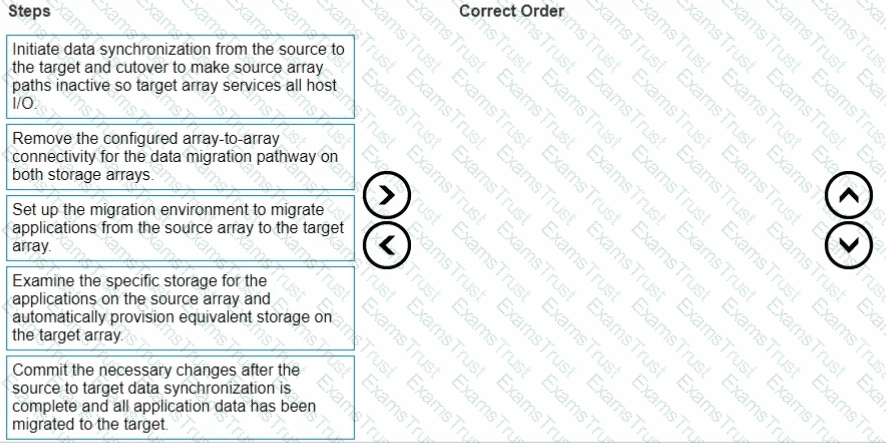
Which emulations can be added through the SYMCLI?
What takes place during an SRDF Restore operation?
Place the steps in the correct order to create clone copy sessions of device groups.
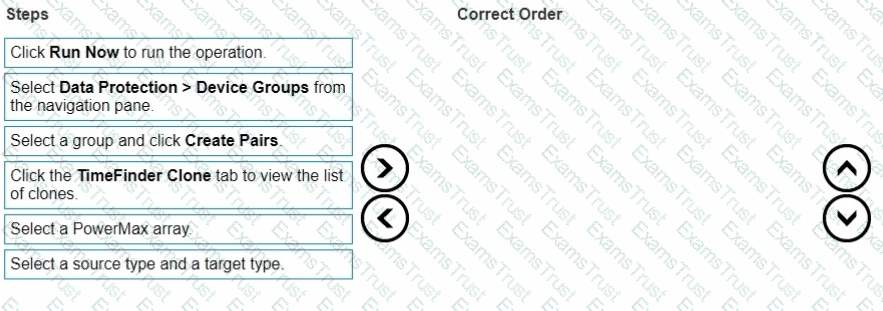
Production work has been started on the R2 devices after an 5RDF Failover operation. Where will the changes made to the R2 devices be reflected in the SRDF Query output shown in the exhibit?

What is a recommendation when using Open Replicator to migrate data from a supported third-party array to a VMAX3 array?
When creating SRDP groups, what is always identical on both the participating arrays?
Exhibit.
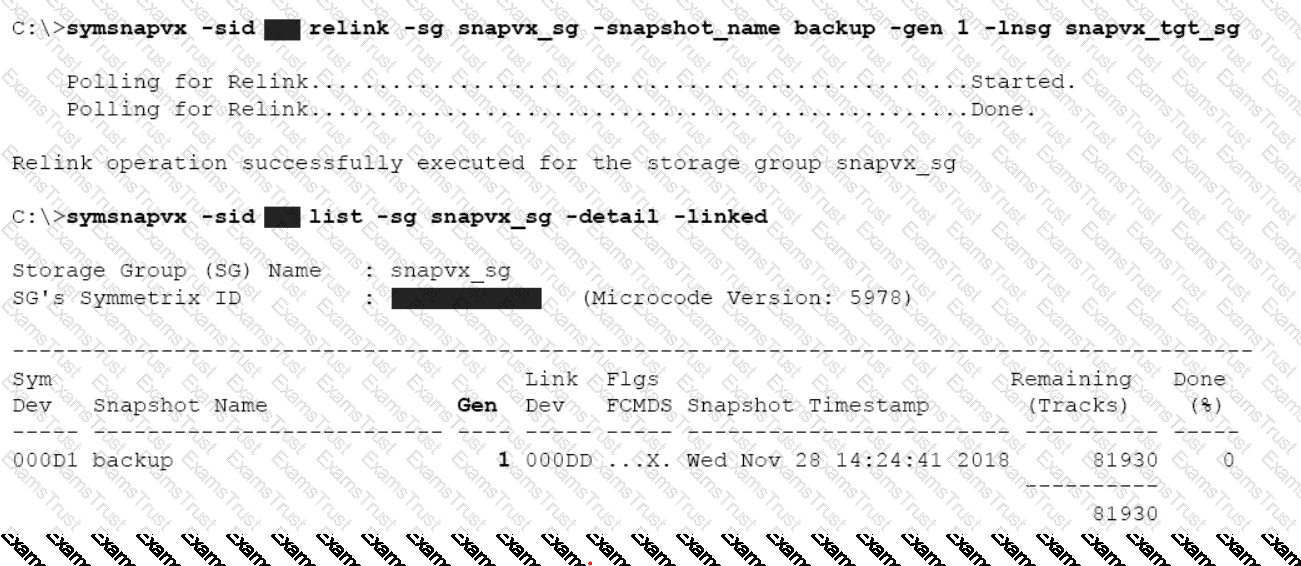
Which activity needs to be performed prior to the operations shown in the exhibit?
What is the maximum capacity per array in a PowerMax 8500?
What is a minimum requirement for Dell EMC VSI 8.0 on a VMAX All Flash array?
Based on the exhibit, what does the “Done %” column represent?
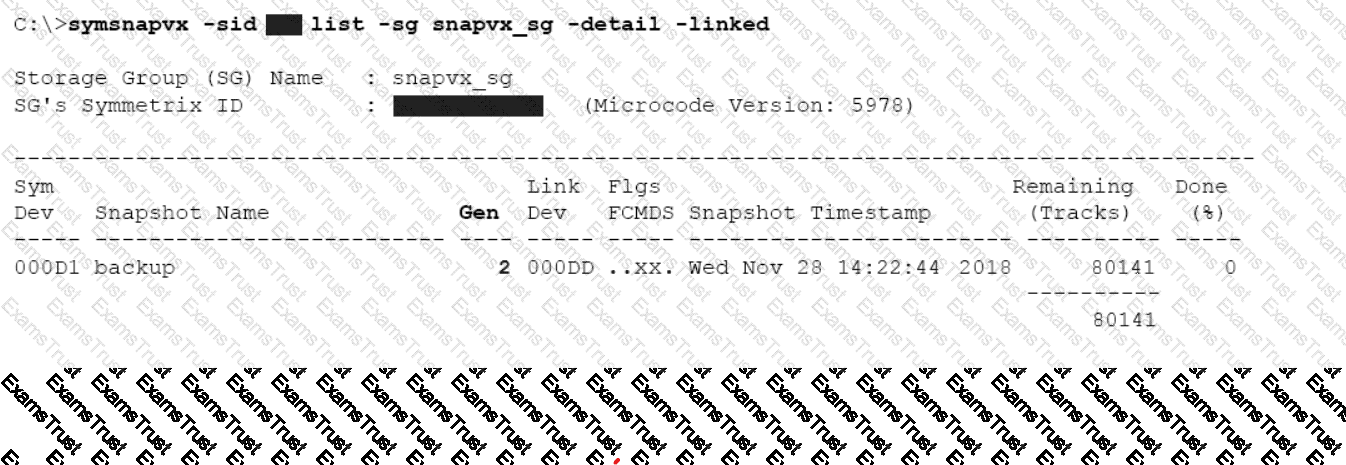
When using TimeFinder SnapVX, what is the maximum number of linked targets allowed per source?
A Storage Administrator runs the command:
syradm list -environment -offline
What migration environments are listed?
A TimeFinder SnapVX snapshot of a Storage Group was created with a time-to-live setting of seven days Fourteen days after snapshot creation, a query shows that the snapshot still exists
What is a possible reason for this issue?
On a PowerMax array, what is the default Dynamic I/O distribution mode setting when a Storage Group is associated with Host I/O Limits'?
A systems administrator has decommissioned a host with two devices allocated to it. What must the administrator do prior to deleting the devices?
A company is setting up a multi-tenant environment where multiple departments share the same storage array with SID 1762. The IT department requires 2 TB of storage to be available on the ESXi1 host. Use "ESXi1_SG" for the storage group name, create a port group with Dir- Ports "OR-1C:0 and OR-2C:0," and leave all other settings at their default.
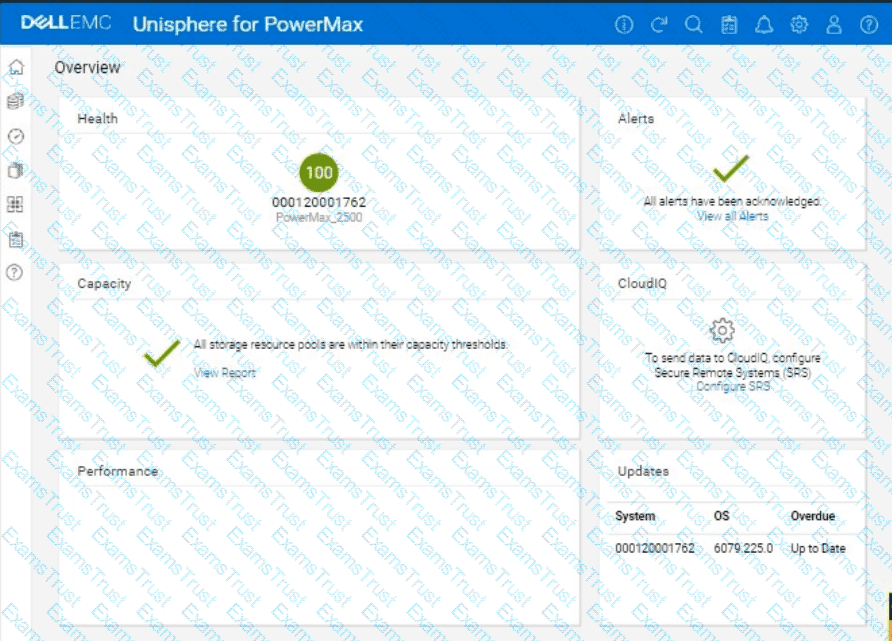
Using the simulator, provision the storage required with a single volume using auto-provisioning groups.
The Reserved Capacity for a PowerMax Storage Resource Pool (SRP) has been set to 15%. A TimeFinder SnapVX snapshot has been created for a Storage Group containing 10 devices. An application is actively performing read and write I/Os to these devices. The snapshot is linked to the target in Copy mode. Allocation for the SRP reaches 85%.
What will happen to the copy process?
What will prevent a LUN from being assigned to a second Storage Group?
A systems administrator uses the symrdf createpair command to create an R1/R2 pair. Both devices are dynamic SRDF devices.
What is the default mode of operation for the SRDF pair when the Establish operation is performed?
A systems administrator created a secure snapshot using the -secure -delta 5:12 parameter. When can the snapshot be deleted?
SRDF/A has been enabled between two PowerMax arrays in Multi-Session Consistency mode An extended loss of all RDF links occurs. What will the RDF pair states be after link connectivity is restored?
A systems administrator plans to use Non-Disruptive Migration (NDM) to migrate data from a VMAX array running Enginuity 5876 to a PowerMax running PowerMaxOS 5978 Which NDM mode will be used?
Which SYMCLI command can be used to create a new TDEV and assign it to a Storage Group in one step?
What information would you expect to see under the System > Hardware view on a newly installed Unisphere for PowerMax deployment on 2000 and 8000 series arrays?
In Unisphere which role has limited privileges that can only view the information about a storage array and is unable to make any configuration changes?
Which service has to be manually started first when Unisphere services are down?
If a data reduction hardware I/O module fails, what happens to incoming data?
What is the purpose of the SYMAPI options file?
A non-production environment has been created with a VMFS Datastore named TestDS and a virtual machine named TestVM. SRDF/S has been configured between two PowerMax arrays One ESXi server is connected to the R1 device and another is connected to the R2 device. The VMFS Datastore resides on the R1 device. The systems administrator wants to test the environment for disaster recovery readiness To simulate a disaster on the R1 side a graceful failover will be done. What is the correct sequence of steps on the R1 side of the test environment to perform a graceful failover?

What is the maximum size that can be created for externally visible devices in PowerMax and VMAX Family arrays?
Refer to the exhibit.
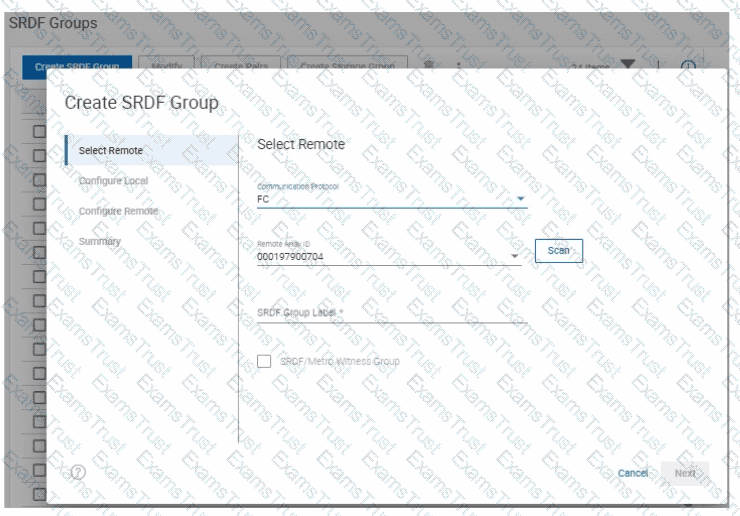
SRDF/Metro has been configured between two arrays using a physical witness.
When creating a new SRDF group for the configuration, why is the option to create an SRDF/Metro Witness Group greyed out?
A host has LUNs assigned through a Masking View containing one regular Storage Group The Storage Group has the gold service level assigned One LUN requires a higher service level What is the correct sequence of steps required to assign the platinum service level to that LUN?
